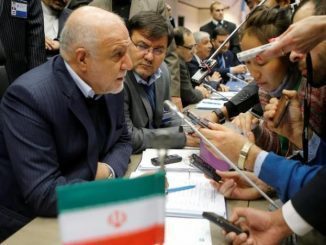
OPEC is moving closer toward finalizing this month its first deal since 2008 to limit oil output, with most members prepared to offer Iran significant flexibility on production volumes, after Iran refused to reduce its production during the past months putting more pressure on the global price.
Iran made the historic nuclear deal with P5+1 powers upon last year, in which Tehran agreed to amend its nuclear output in order to lift all nuclear-related economic sanctions, freeing up tens of billions of dollars in oil revenue and frozen assets.
Iran has managed to increase oil exports significantly in 2016 after the lifting of sanctions in January.
Earlier this year, Tehran refused to join an initiative to boost prices by freezing output but signaled it would be part of a future effort once its production had recovered sufficiently. OPEC has no supply limit, having at its last meeting in December scrapped its production target.
According to International Energy Agency (IEA) figures, Iran’s output has reached levels seen before the imposition of sanctions over its nuclear program. Tehran says it is not yet there.
These changes caused instability in the oil market, while OPECand other oil producing parts tried to restabilize it.
OPEC members suggested recently an oil output cut of 4.0-4.5 percent for all of its members, but the deal’s success hinges on an agreement with Iraq and Iran, which are far from certain to give full backing.
Iran and Iraq raised certain conditions for participating in the deal, according to sources, who were not allowed to speak on the record because the experts were meeting behind closed doors.
Iran was asked to cut 4.5 percent from almost 4 million bpd, according to sources. But Tehran has signaled it wants to cut from higher levels of 4.1-4.2 million bpd, one of the sources said.
Iraq was asked to cut about 200,000 bpd. Baghdad is also still debating whether it should cut from the levels of OPEC’s estimates or its own, higher, production figures.
A show of power
Iran, according to delegates from other OPEC members, is unlikely to restrain supplies, given that it believes Saudi Arabia should cut back itself to make room for Iranian oil, in a clear sign of the tension and clash for power between the regional rivals.
The new proposal would see all member countries cutting 4-4.5 percent from OPEC’s estimates of their October production with the aim of reaching a total output target of 32.5 million bpd, OPEC sources have said.
Sources said Saudi Arabia and its Gulf allies have signaled they were prepared to cut close to 1 million bpd of their output, as Saudi Arabia alone could cut up to 500,000 bpd.
“Eighty-five percent of proposed OPEC cuts are from Gulf countries but Iran is still not in favor,” one source said.
These numbers means that Gulf countries will be cutting important income for the sake of stabilizing the market, but Iran is still refusing, wanting to increase the pressure on them in a show of power.
Saudi Arabia produced a near-record-high 10.26 million barrels per day in April and has kept output relatively steady over the past year, and refused to cut its production in order to give Iran its share and keep the market steady.
The signals that Tehran has been sending seem to be clear: the country’s top priority is reviving its energy industry after years of sanctions and its willingness to contribute to a production curb is very conditional.
Last weekend, President Hassan Rouhani officially launched commercial production at three fields along Iran’s border with Iraq, effectively adding 220,000 bpd to its output. Plans are to ramp this additional output by1 million bpd.
Even if Iran agrees to this level of production, it means Saudi Arabia will be cutting most of the production if the deal goes through—something Saudi Arabia was previously adamant that it would not do.
For more than a decade after oil crashed to $10 in 1997, the two set aside rivalries to manage the market and support prices, although they fell into opposing OPEC camps with Iran wanting high prices and Saudi more moderate.
Now, the Sunni-Shia conflicts setting Saudi Arabia and Iran at each other’s throats, particularly in Syria and Yemen, make the relationship between the two even more fraught.



